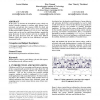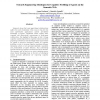611 search results - page 85 / 123 » Using GP to Model Contextual Human Behavior |
EXPERT
2010
13 years 5 months ago
2010
Human behavior recognition is one of the most important and challenging objectives performed by intelligent vision systems. Several issues must be faced in this domain ranging fro...
IPPS
1998
IEEE
14 years 6 days ago
1998
IEEE
The paper presents how the Random PROLOG Processor (RPP), a bio-inspired model of computations, can be used for formalization and analysis of a phenomenon - the Collective Intelli...
ICMI
2004
Springer
14 years 1 months ago
2004
Springer
In this paper, we describe the GroupMedia system, which uses wireless wearable computers to measure audio features, headmovement, and galvanic skin response (GSR) for dyads and gr...
PUC
2010
13 years 6 months ago
2010
This paper provides a framework for recording, analyzing and modeling of 3 dimensional emotional movements for embodied game applications. To foster embodied interaction, we need i...
COMPSAC
2008
IEEE
14 years 2 months ago
2008
IEEE
Research shows that most agent-based collaborations suffer from lack of flexibility. This is due to the fact that most agent-based applications assume pre-defined knowledge of age...



